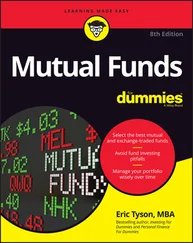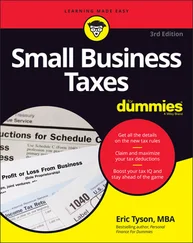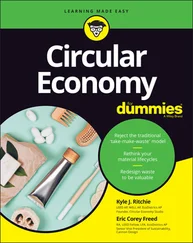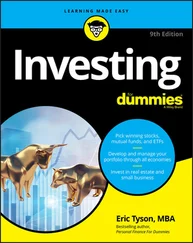1 ...8 9 10 12 13 14 ...17 If you’re self-employed, you can establish your own retirement savings plans for yourself and any employees you have. Simplified Employee Pension-Individual Retirement Accounts (SEP-IRA) allow you to put away up to 20 percent of your self-employment income up to an annual maximum of $58,000 (for tax year 2021).
Individual Retirement Accounts
If you work for a company that doesn’t offer a retirement savings plan, or if you’ve exhausted contributions to your company’s plan, consider an Individual Retirement Account (IRA). Anyone who earns employment income or receives alimony may contribute up to $6,000 annually to an IRA (or the amount of your employment income or alimony income, if it’s less than $6,000 in a year). A nonworking spouse may contribute up to $6,000 annually to a spousal IRA.
Your contributions to an IRA may or may not be tax-deductible. For tax year 2021, if you’re single and your adjusted gross income is $66,000 or less for the year, you can deduct your full IRA contribution. If you’re married and you file your taxes jointly, you’re entitled to a full IRA deduction if your AGI is $105,000 per year or less.
 If you can’t deduct your contribution to a standard IRA account, consider making a contribution to a nondeductible IRA account called the Roth IRA. Single taxpayers with an AGI less than $125,000 and joint filers with an AGI less than $198,000 can contribute up to $6,000 per year to a Roth IRA. Although the contribution isn’t deductible, earnings inside the account are shielded from taxes, and unlike withdrawals from a standard IRA, qualified withdrawals from a Roth IRA account are free from income tax.
If you can’t deduct your contribution to a standard IRA account, consider making a contribution to a nondeductible IRA account called the Roth IRA. Single taxpayers with an AGI less than $125,000 and joint filers with an AGI less than $198,000 can contribute up to $6,000 per year to a Roth IRA. Although the contribution isn’t deductible, earnings inside the account are shielded from taxes, and unlike withdrawals from a standard IRA, qualified withdrawals from a Roth IRA account are free from income tax.
 Should you be earning a high enough income that you can’t fund a Roth IRA, there’s an indirect “backdoor” way to fund a Roth IRA. First, you contribute to a regular IRA as a nondeductible contribution. Then, you can convert your regular IRA contribution into a Roth IRA. Please note that this so-called backdoor method generally only makes sense if you don’t have other money already invested in a regular IRA because in that case, you can’t simply withdraw your most recent contribution and not owe any tax.
Should you be earning a high enough income that you can’t fund a Roth IRA, there’s an indirect “backdoor” way to fund a Roth IRA. First, you contribute to a regular IRA as a nondeductible contribution. Then, you can convert your regular IRA contribution into a Roth IRA. Please note that this so-called backdoor method generally only makes sense if you don’t have other money already invested in a regular IRA because in that case, you can’t simply withdraw your most recent contribution and not owe any tax.
Annuities: Maxing out your retirement savings
What if you have so much cash sitting around that after maxing out your contributions to retirement accounts, including your IRA, you still want to sock more away into a tax-advantaged account? Enter the annuity. Annuities are contracts that insurance companies back. If you, the investor (annuity holder), should die during the so-called accumulation phase (that is, before receiving payments from the annuity), your designated beneficiary is guaranteed reimbursement of the amount of your original investment.
Annuities, like IRAs, allow your capital to grow and compound tax-deferred. You defer taxes until you withdraw the money. Unlike an IRA, which has an annual contribution limit of a few thousand dollars, an annuity allows you to deposit as much as you want in any year — even millions of dollars, if you’ve got millions! As with a Roth IRA, however, you get no upfront tax deduction for your contributions.
 Because annuity contributions aren’t tax-deductible, and because annuities carry higher annual operating fees to pay for the small amount of insurance that comes with them, don’t consider contributing to one until you’ve fully exhausted your other retirement account investing options. Because of their higher annual expenses, annuities generally make sense only if you won’t need the money for 15 or more years.
Because annuity contributions aren’t tax-deductible, and because annuities carry higher annual operating fees to pay for the small amount of insurance that comes with them, don’t consider contributing to one until you’ve fully exhausted your other retirement account investing options. Because of their higher annual expenses, annuities generally make sense only if you won’t need the money for 15 or more years.
Selecting retirement account investments
When you establish a retirement account, you may not realize that the retirement account is simply a shell or shield that keeps the federal, state, and local governments from taxing your investment earnings each year. You choose what investments you want to hold inside your retirement account shell.
You may invest the money in your IRA or self-employed plan retirement account (SEP-IRAs and so on) in stocks, bonds, mutual funds, and some other common investments, including bank accounts. Mutual funds (offered in most employer-based plans) and exchange-traded funds (ETFs) are ideal choices because they offer diversification and professional management. See Chapter 10for more on mutual funds and ETFs.
Assessing Your Risk-Taking Desires
With money that you’re investing for shorter-term goals, you have a more limited menu of investments to choose among. For your emergency/rainy-day fund, for example, you should consider only a money market fund or bank/credit union savings account. Down-payment money for a home purchase that you expect to make in a few years should be kept in short-term bonds.
When you’re younger and have more years until you plan to use your money, you should keep larger amounts of your long-term investment money in growth (ownership) investments, such as stocks, real estate, and small business. The attraction of these types of investments is their potential to really grow your money, but the risk is that the value of such investments can fall significantly.
The younger you are, the more time your investments have to recover from a bad fall. A long-held guiding principle says to subtract your age from 110 and invest the resulting number as a percentage of money to place in growth (ownership) investments. So if you’re 30 years old, 110 − 30 = 80 percent in growth investments
Should you want to be more conservative, subtract your age from 100: 100 − 30 = 70 percent in growth investments.
Want to be even more aggressive? Subtract your age from 120: 120 − 30 = 90 percent in growth investments.
 These guidelines are general ones that apply to money that you invest for the long term (ideally, for ten years or more). In your younger adult years, you can consider investing all of your money in retirement accounts in stocks and stock funds given the long time frame you have with such accounts.
These guidelines are general ones that apply to money that you invest for the long term (ideally, for ten years or more). In your younger adult years, you can consider investing all of your money in retirement accounts in stocks and stock funds given the long time frame you have with such accounts.
Chapter 3
Setting Your Return Expectations
IN THIS CHAPTER
 Looking at expected returns from common investments
Looking at expected returns from common investments
 Understanding the power of how returns compound over time
Understanding the power of how returns compound over time
We invest to earn returns. In my experience as a former financial advisor and as a writer interacting with many folks, I still find it noteworthy how many people have unrealistic and inaccurate return expectations for particular investments.
Where do these silly numbers come from? There are numerous sources, most of which have a vested interest in convincing you that you can earn really high returns if you simply buy what they’re selling. Examples include newsletter publishers and writers, some financial advisors, and various financial publishing outlets.
Читать дальше
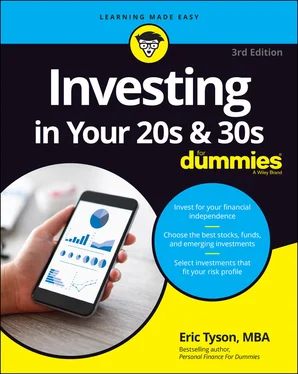
 If you can’t deduct your contribution to a standard IRA account, consider making a contribution to a nondeductible IRA account called the Roth IRA. Single taxpayers with an AGI less than $125,000 and joint filers with an AGI less than $198,000 can contribute up to $6,000 per year to a Roth IRA. Although the contribution isn’t deductible, earnings inside the account are shielded from taxes, and unlike withdrawals from a standard IRA, qualified withdrawals from a Roth IRA account are free from income tax.
If you can’t deduct your contribution to a standard IRA account, consider making a contribution to a nondeductible IRA account called the Roth IRA. Single taxpayers with an AGI less than $125,000 and joint filers with an AGI less than $198,000 can contribute up to $6,000 per year to a Roth IRA. Although the contribution isn’t deductible, earnings inside the account are shielded from taxes, and unlike withdrawals from a standard IRA, qualified withdrawals from a Roth IRA account are free from income tax. Because annuity contributions aren’t tax-deductible, and because annuities carry higher annual operating fees to pay for the small amount of insurance that comes with them, don’t consider contributing to one until you’ve fully exhausted your other retirement account investing options. Because of their higher annual expenses, annuities generally make sense only if you won’t need the money for 15 or more years.
Because annuity contributions aren’t tax-deductible, and because annuities carry higher annual operating fees to pay for the small amount of insurance that comes with them, don’t consider contributing to one until you’ve fully exhausted your other retirement account investing options. Because of their higher annual expenses, annuities generally make sense only if you won’t need the money for 15 or more years. These guidelines are general ones that apply to money that you invest for the long term (ideally, for ten years or more). In your younger adult years, you can consider investing all of your money in retirement accounts in stocks and stock funds given the long time frame you have with such accounts.
These guidelines are general ones that apply to money that you invest for the long term (ideally, for ten years or more). In your younger adult years, you can consider investing all of your money in retirement accounts in stocks and stock funds given the long time frame you have with such accounts. Looking at expected returns from common investments
Looking at expected returns from common investments